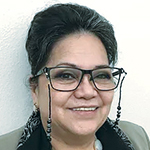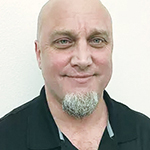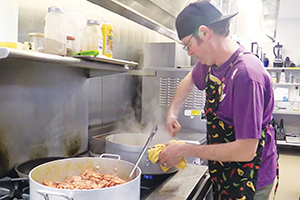By COLLEEN SCHRAPPEN
Jamie George had been through eight drug treatment programs for heroin dependency when he checked into Waterfront Recovery Services on Dec. 5, 2018.
The date is now imprinted in his memory forever, he says. It was the start of a seven-day detox, followed by two months of residential care, and the first time since he was 19 that George, now 55, felt like his life was his again.
"It was a game changer for me," he said.
The program offers the only medically managed detox and treatment in Northern California that cares for indigent patients — and that's what made the difference for him, George said.
Waterfront Recovery Services opened in November 2018 in Eureka, a port city about 100 miles south of Oregon. But without the financial support of organizations such as St. Joseph Hospital in Eureka, California, Waterfront Recovery Services may not have
come to be, much less survived long enough to be the refuge it has been for patients like George.
Shift in treatment
Initially, an investment of $1.2 million was made through the Well Being Trust to provide the drug and alcohol treatment program with funding to hire a medical director and nursing staff. The Well Being Trust
was launched by Providence St. Joseph Health in 2016 to advance the mental, social and spiritual health of the country. St. Joseph Hospital is part of the Providence St. Joseph Health system.
Medically based programs, such as the one at Waterfront Recovery Services, are becoming more common as the thinking behind how to treat substance
use disorders has shifted toward an integrated care model of mental and physical heath.

Bayan
George said that unlike Waterfront Recovery Services, the first eight treatment programs he went through did not have a medical doctor on staff. He credits Dr. Ruby Bayan, a psychiatrist who is medical director of Waterfront Recovery Services, and the
suboxone treatment he began there with allowing him to achieve and maintain sobriety. He said the suboxone eliminates his drug cravings.
An important premise that underpins this type of treatment is that addiction is a medical, not criminal, problem. And it's not an uncommon one: According to the National Institutes of Health, more than 20 million Americans have a substance abuse disorder.
Keeping the wheels turning
The idea for Waterfront Recovery Services began taking shape about five years ago. Fatal drug overdoses were happening at three times the rate in Humboldt County, where Eureka is the county seat, as they
were in the rest of California. Patients were visiting the emergency room for drug-related problems twice as often as elsewhere in the state.

Dr. Ruby Bayan, left, medical director of Waterfront Recovery Services, makes a presentation during a meeting with stakeholders from local government, medical and mental health agencies and law enforcement. Bayan has worked in psychiatric and substance
abuse treatment for more than three decades.
"We had seen the effects of the lack of treatment in our community and in our hospital," said Martha Shanahan, the manager of community health investment for St. Joseph Hospital.
Shanahan said when funding for Drug Medi-Cal, the Medicaid coverage for substance use disorder treatment, was delayed from January 2019 to July 2020, it put Waterfront Recovery Services in jeopardy. "We thought, 'Can we keep the wheels turning on this?'"
St. Joseph Hospital provided $500,000 in bridge funding that kept the treatment facility afloat for those 18 months. Now four out of five Waterfront Recovery Services patients use Drug Medi-Cal coverage to pay for treatment.
Previously, low-income or uninsured people with substance-use disorder had few options except to go to the emergency room. But after detoxing at the hospital, they would be right back where they started — often with untreated mental health issues,
physical problems and no prospects for a job or education.
Waterfront Recovery Services addresses all of those factors during treatment. Residents stay for 30, 60 or 90 days, engaging in therapy, family treatment programs, even yoga and art workshops.
Covering the cost
It's effective, but expensive, said John McManus, executive director of Waterfront Recovery Services.

McManus
"Treatment programs are tasked with solving one of society's largest problems, but the resources thrown at the problems are miniscule," McManus said.
Not having a program like Waterfront, which provides medical detox, residential treatment and help with transitioning to sober housing, is even more expensive, though. Before it opened, "we had 'hyper-utilizers' who rolled through services and could never
get what they needed in a timely manner," he said.
A nine-bed Victorian home, called C Street Detox, was one of the few local options for residential treatment, and it was crumbling. McManus headed C Street Detox, and also oversaw two other longer-term treatment programs, one for men and one for women.
The building that houses Waterfront became available in July 2017 and the local government agreed to lease it to Waterfront for a dollar a year. With the startup funding from St. Joseph, support from Humboldt County and grant money, Waterfront was able
to open with 56 beds, doubling the capacity of the other three programs and folding them into one location.
"We would not have survived without help from St. Joseph," said McManus.
Reaching the neediest
Waterfront has been mostly unfazed by the pandemic. Patients and staff undergo weekly testing for COVID-19. The facility did have to decrease its bed capacity to meet social distancing requirements but has
otherwise continued operations under the guidance of the California Department of Public Health. The administrators encourage everyone who is part of the program to be vaccinated; proof of vaccination is required for visitors.

Jesse Pearson, a kitchen manager at Waterfront Recovery Services, prepares a nutritious meal. Homemade mole and a piñata for Cinco de Mayo and a special brunch including chocolate dipped strawberries on Mother's Day are examples of some of
the food-centered celebrations the kitchen produces to make residents feel like they're part of a community.
With the Drug Medi-Cal program up and running, McManus feels secure that he and the Waterfront team will be able to continue to reach those most in need: seven out of 10 of those receiving treatment at Waterfront are homeless.
He commends Bayan and the rest of the staff of almost 50 for helping patients such as George remain successful even after their stay at Waterfront is over.
"We prepare them for social challenges when they leave," said Bayan, who has worked in psychiatric and substance abuse treatment for more than three decades.
Detoxing and coping skills
Waterfront provides two kinds of treatment: withdrawal management that uses medication protocols to make detoxing as comfortable and safe as possible and residential treatment of up to 90 days to help
patients understand addiction, learn healthy coping skills and prepare for return to the community.
In addition to participating in group and individual therapy sessions, patients in residential treatment at Waterfront start on a path toward work or returning to school. They are guided through getting replacement documents including Social Security
cards, driver's licenses, even birth certificates that may be necessary to land a job or be approved for government aid.
George, who had been living in a van for years before his stay at Waterfront, now has an apartment for himself and his dog, Shunka. He bought a motorcycle and enrolled in addiction studies at the College of the Redwoods. He works at Waterfront as a counselor.
"Dr. Bayan saw something in me," said George.
He's not the exception, though. It's what she recognizes in all her patients, and what keeps her going:
"People work here not to earn money. It's not a high-paying job," Bayan said. "When you see the most broken person, when you see the light in their eyes, the humanity, it makes it worthwhile."